#bcs/brba music analysis
Explore tagged Tumblr posts
Text
as I've been watching s6 of bcs I've noticed the music cues are resembling the music cues from brba. to me it seems that as the timelines converge, the music is getting more and more similar. this prompted me to do a deep dive into music transcription and analysis between the two shows, which I'll post as I complete them. (side note: @jmcgools sent me an interview with dave porter which confirmed my theory!!!! interview is linked here x)
a few general comments before going into the first cue analysis....doing a full stylistic analysis entails analyzing SHMRG (Sound, Harmony, Melody, Rhythm, Growth). I am focusing mainly on the melodic and rhythmic elements because dave porter stays fairly consistent in the sound, harmonic, and growth elements throughout both shows:
the sound/timbre used is typically guitars, various percussion, and other electronic sounds; the sound/texture is typically sparse, which fits dave's intention to keep the music subservient to the narrative.
the harmony is also sparse in both shows for the same reasons, and is either centered in a minor tonality or no tonality at all.
and with growth, dave masterfully follows the narrative, and so each cue is somewhat unique in that aspect.
the first comparison I've completed is between the credits from brba 4x02: thirty-eight snub x (the credits hit when jesse is dissociating in his house alone with his stereo music blasting behind him) and the scene in bcs 6x04: hit and run x is when kim confronts the people tailing her

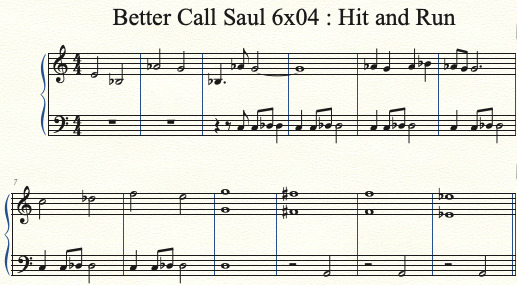
the music cue in the credits scene is short-lived, but has distinct melodic content that is recognizable in hit and run. the pattern starts with A, C, Db, C, then develops in measure 4-5 into A, C, Db, F, E. the developed melodic contour is repeated almost exactly in hit and run in measure 7-8. only the rhythm changes slightly
narratively, both scenes have an undercurrent of anxiety and dread. the minor 2nd motions between the C and Db and the F and E both accomplish that (think the jaws theme). the hit and run cue increases the intensity with the brief ostinato (repeating pattern in the bass line), continuing the minor 2nd motif between the C and Db. this minor 2nd motif is even further developed in the last 4 measures of the cue with the descending G, F#, F and then it ends with a tritone between A and Eb (one of the most unstable intervals) leaving the viewer unsettled.
These are both very short cues, but they have a lot packed into them! As with all of the music in brba and bcs, the creators use it sparingly, but when it is used it makes it that much more impactful.
This posted ended up being waaaaaay longer than I intended 😅 so thanks for reading this far! Let me know what you think or if you have any interpretations yourself. and feel free to drop suggestions for other cues for me to analyze! I’m hunting down cues to compare in my rewatches, but I know for sure that I won’t catch all of them lol
bcs/brba music analysis 1/??
#bcs/brba music analysis#better call saul#brba#music#ps: I tried to upload videos of the scenes but tumblr.hell wouldn't let me#then I tried to upload the mp3s and again tumblr.hell wouldn't let me#so I had to resort to inserting hyperlinks to a bum soundcloud account I just created lol#anyway if any of you know how to upload multiple videos and or audio files to a tumblr post let me know!!#*op
103 notes
·
View notes
Text
I was rewatching 6x10: Nippy today, and I screamed and nearly jumped off the couch when I realized that there is a parallel between a cue in this episode and a cue from 3x10: Lantern, which I analyzed previous here. The cue from Lantern, titled “Chuck’s Relapse” (x) is played when Chuck is tearing down his house. The cue from Nippy, “Back in the Game,” (x) is first played when Gene is in his house after he has confronted Jeff and told then him he would help him get into “the game.” This cue is also played a few other times throughout the episode.
My analysis is under the cut!
bcs/brba music analysis 9/??
The most direct parallel between the two cues is the use of an ethereal, high register drone which is played with the same timbre. I’m not 100% certain what the instrument is, but I think it’s a violin playing harmonics. In both cues the ethereal drone is initially pitched at C#6. The sequence of pitches changes after that, but I do find it very interesting that Porter chose to use C#6 for both!
(you'll see the C#6 transcribed in the Nippy cue but not the Lantern cue because when analyzing the Lantern cue previously the C#6 wasn't significant and I really didn't want to type out the transcription again 😅😅)
Additionally, a few of the melodic patterns in “Chuck’s Relapse are referenced in “Back in the Game”


"Chuck's Relapse" introduced the pattern La, Do, Ti, So, Si in the key of A minor . This pattern referenced in a reduced form in "Back in the Game" as La, Ti, Si in the key of E minor. The Do and So are removed but the basic harmonic structure is the same in both cues.


The pattern So Do Ti ends the first iteration of Chuck's motif in this cue. It is referenced in the same key in "Back in the Game" with one slight change. While the starting pitch of the material is different both of these patterns are built off a Cmajor 7 chord (C, E, G, B). Ending on a major 7 chord draws a parallel between the two scenes and it also leaves the cue unresolved and helps build tension as the scenes end.
The common ties in these two music cues helps to strengthen the narrative parallels that are happening between these two episodes. The narrative in both scenes has the subject relapsing into something they had either suppressed or overcome. For Chuck, being forced out of HHM caused a relapse of his mental illness which ultimately led to his suicide. For Gene, helping Jeff get into the game is the first step back into his relapse of scamming and his Saul persona. Out of necessity for survival and not getting caught, he devises a scam to keep Jeff quiet about his true identity. After his initial trepidation Gene is feeling alive again at the end of the episode after getting a taste of the scam. Although he doesn’t dive headfirst into his old ways right away, his phone call with Kim in the following episode prompts him to double down on the Saul persona and scamming to numb the pain.
Bravo to Dave Porter for this one!! I am continually amazed by the amount of detail that is put into every aspect with of this show. The more I rewatch to these episodes and relisten to the cues, the more parallels I find.
As always please feel free to comment and let me know what you think of the analysis!
#better call saul#bcs/brba music analysis#bcs s6#lantern#nippy#jimmy mcgill#gene takovic#chuck mcgill#the brothers mcgill
33 notes
·
View notes
Text
A new episode, a new analysis!!
jfc….Point and Shoot emotionally wrecked me. Is everyone else doing ok?? Because I am not 😩
Anyway, I’ve been wanting to analyze Chuck’s motif from 3x10: Lantern for a while now, but I hadn’t gotten around to it…but then I watched 6x08: Point and Shoot. When I watched it at Tribeca I thought that I heard chuck’s motif in howard’s burial theme, but I wasn't certain. I only got to listen to it that one time at the showing, and I was so focused on other things. I'd been waiting anxiously for three weeks to finally see the episode again last night so I could listen and verify it lmao and goddamn it!!! Dave Porter has done it to us again!!!
analysis is under the cut!!
bcs/brba analysis 5/??
Chuck’s motif is used in two separate cues in Lantern, “Lights Off” and “Chuck’s Relapse” The theme is in 6/4 time and in the key of A minor* You can see the melodic and rhythmic content below. I used solfege to denote the scale degrees so it can easily be compared to the other cue.
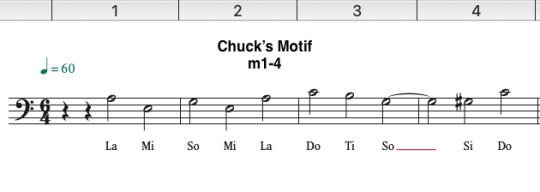

The cue from Point and Shoot is titled “Burial”. It includes Chuck’s motif as a counter melody above the beautiful, heart-wrenching melody in the cello 😭😭 The biggest changes between the two cues are 1) the original is voiced in the bass range, while the Point and Shoot cue is voiced in the treble range, and 2) the instruments used. The original uses a trumpet or maybe a flugelhorn because it’s so low (I don’t know for certain) and the Point and Shoot cue what sounds to me like a vibraphone or some other pitched percussion instrument (perhaps even electronic). One interpretation I had about these changes is that the motif is pitched higher with the vibraphone to be more ethereal...like Chuck is a shadow behind Howard's death. Aside from that, there are just a few rhythmic, harmonic, and melodic differences, but the material is similar enough to be easily heard.
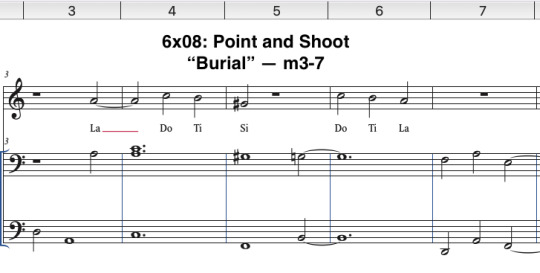
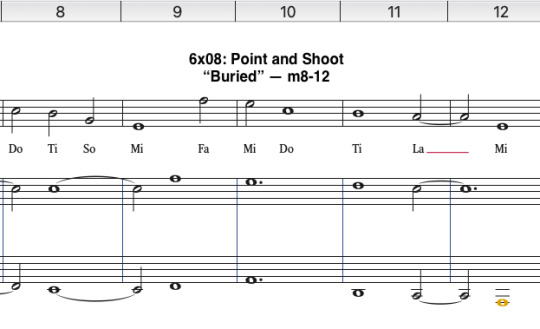
In Lantern, Chuck’s motif is further developed in “Chuck’s Replase” by voicing the main melody in an electric piano instead of a brass instrument, moving the melody to the treble range, and by thickening the texture through additional voices. (I didn't include the full transcription, but here's a sample!) The texture get thicker and the melody becomes more embellished to build tension as Chuck slips further into the grasp of his mental illness 😩
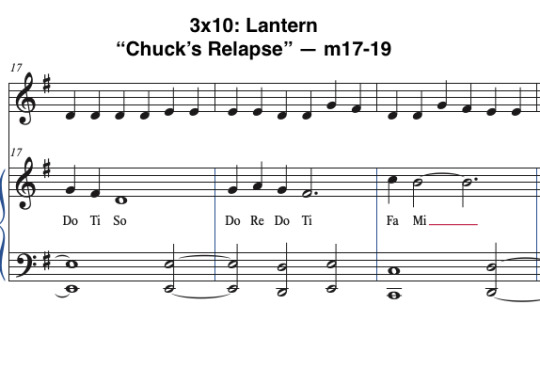

The parallels between Chuck’s and Howard’s deaths are numerous, and people much smarter than me have posted great meta on it. They were both gaslit by Jimmy when he switched something out (numbers/photos) and they were both made a fool in front of their peers and colleagues, reputations forever tainted.
Another very interesting thing about this cue is that after closer inspection, I realized that this cue is also found in 5x08: Bagman and 6x03: Rock and Hard Place, which I analyzed previously here.
The biggest changes with these cues are the time signature (4/4 instead of 6/4), the key signatures, and the instrumentation. The melodic content is very similar with just a few changes.
Chuck colors Jimmy’s story everywhere you turn, so it’s easy to see how and why this motif showed up in Bagman when Jimmy uses the *space blanket* to lure in the bad guy. However, I’m puzzled about how and why it is in Nacho’s cue in Rock and Hard Place. I’m sure there’s a reason, I just haven’t dug deep enough to find it yet. If anybody has any theories on that, please chime in!! I’d love to hear them.
*for the music theory nerds out there: even though it's in a minor key, I labeled the solfege as if it were in a major key because less altered syllables are used. this method is called La-based minor, where the tonic is La instead of Do
#bcs/brba music analysis#better call saul#bcs s6 spoilers#lantern#point and shoot#bagman#rock and hard place#chuck mcgill#*op
46 notes
·
View notes
Text
what’s that? another music analysis?!
lmao I had this afternoon off because I had a small procedure done, so when I got home from the doctor, I was finally able to work on this analysis that I’ve been sitting on for a few weeks 😅
anyway…this analysis is comparing two cues in season 6. the first is the “Motel Shoot Out” from 6x02: Carrot and Stick (x) and the second is “It Was Ignacio” from the 6x11: Breaking Bad teaser (x)
my analysis is under the cut!
bcs/brba music analysis 8/??
Dave Porter introduces the motif transcribed below in the 6x02 cue:

the tempo and the rhythm are quick, and the note are moving in a descending chromatic pattern before suddenly switching to move the opposite direction in an ascending chromatic pattern (chromatic movement in music is when a melodic line moves through every half step in the scale. for example: c, c#, d, d#, e, f, f#, etc. this is similar but slightly different from chromaticism for the music theory nerds out there. if you want any clarification feel free to dm me!)
this quick half-step motion heightens the tension and anxiety in the scene as Nacho is trying to escape from the motel as the cousins try to hunt him down. the intensity is dialed up even further as Porter transposes the motif up by half steps. the motif is originally introduced in e minor and then he quickly modulates to f minor and then f# minor:


in 6x11: Breaking Bad, Porter uses this motif again. this time the tempo and rhythm are a bit slower--he uses quarter notes instead of eighth notes--and he sticks with only using the descending chromatic movement. however, the intensity isn’t dialed down at all because of his use of the rapid rhythm in the percussion

another notable element in this cue is that the types of drums used in this cue (which I didn't transcribe here 😔) are similar to the ones use in the Breaking Bad theme, further blending the two timelines together!
the reason for the reprise of this motif is obvious—Nacho’s influence in the scene. in 6x02 the cousins are hunting down Nacho because they think he is responsible for Lalo’s death, and in 6x11 Saul thinks he’s been kidnapped by Lalo’s men and he yells out to Walt and Jesse, “It wasn’t me, it was Ignacio!”
this motif is short and easy to miss, but once you hear that it’s there it strengthens the merging of the bcs and brba timelines.
as always, feel free to leave a comment, ask a questions, or give your own thoughts on the cues! 💕
22 notes
·
View notes
Text
finally another music analysis!!! ...sort of 😅 this one is very different music analysis from my last few in that it involves analysis of the soundtrack rather than an original score cue. and instead of analyzing the musical elements, I am analyzing the text in the song (I'm counting it as music analysis because the average tumblr user probably doesn't have vast knowledge of opera history lmao)
the cue I'm analyzing is the aria that kim's coworker is listening to when kim receives the call at the pro bono law office in florida. the aria is from the opera La Wally by Catalani and is titled "Ebben! Ne andrò lontana" (x)
the rest of my analysis is under the cut!
bcs/brba music analysis 7/??
what makes this choice of music interesting is the context of the aria within the opera. this aria is sung when the titular character, Wally, decides to leave her home forever. The translated text is below:
"Ah well then! I shall go far away, like the echo of the pious church-bell goes away. There somewhere in the white snow; there amongst the clouds of gold, there where hope, hope is regret, is regret, is sorrow! O from my mother's cheerful house La Wally, La Wally is about to go away from you, from you! Quite far away, and perhaps to you, and perhaps to you, will never more return, nor ever more see you again! I will go away alone and far, there, somewhere in the white snow, I shall go, I will go away alone and far and amongst the clouds of gold!"
both kim and jimmy ran away from their homes after what happened to howard. kim at first more literally when she moved to florida and then figuratively when she essentially erased herself. jimmy was the opposite, running away from who he truly was by donning the mask of saul goodman and then more literally when he was disappeared by the vacuum guy and placed in nebraska.
several lines in the poetry of the song support the parallels in plot between La Wally and kim and jimmy's story, but these were the most striking to me:
"There somewhere in the white snow; there amounts the clouds of gold, there where hope, hope is regret, is regret, is sorrow"
"I will go away alone and far, there, somewhere in the white snow, I shall go away alone..."
I think it goes without saying that kim and jimmy's story is filled with regret and sorrow because they both go away alone and far from their homes and from each other. the mention of the white snow screams gene in nebraska to me. but their story is also filled with hope, however bittersweet, because the end of the series leaves us with a question mark rather than a final period. what is their relationship now and where will they go moving forward?
one could say that these parallels are just a coincidence, but as we have all learned by now, nearly everything, every choice, is intentional--from the script, to the set design, to the costuming, to the music selection, every choice was poured over by the masterful creators of this show. and although some people may never pick up on the context of the opera and that aria, the thoughtfulness behind the decision adds depth to the layers of an already rich and artistic show
#bcs/brba music analysis#better call saul#bcs s6#saul gone#it's thinking about the tragedy of jimmy mcgill hours#it's thinking about the tragedy of kim wexler hours#*op
19 notes
·
View notes
Text
A new analysis, another Kim parallel! 🙂🙃
This analysis compares the Breaking Bad Main Theme (extended version) and the music cue from the ending scene in 6x06: Axe and Grind.
The analysis method I used for these cues is a simplified version of the Shenkerian method, which essentially reduces the music down to its simplest layer by removing auxiliary notes and elaborations to show what makes up the primary tonal structure.
For the Breaking Bad Theme (x) I focused on the first few bars. This motif repeats throughout the cue:

This very simple theme is in D minor, and I have labeled the scale degrees below each note. As you can see below, very little reduction was needed to bring this down to its primary tonal structure. The basic structure climbs up the scale from 3 to 6.

Next is the cue from Axe and Grind, called It Happens Today (x) I am focusing on the B section of the cue, which starts in measure 19.

This cue is in the key of Eb minor, just a half-step above the BrBa theme. As in the BrBa cue, I labeled the scale degrees below the notes. At first glance, these two cues don’t look very similar, but the tonal structure is the same. In the transcription below, I grouped neighboring tones together to show how I found the primary tonal structure. (the second picture shows a structural note in the bass line, which wasn’t included above.)


When the neighboring tones are removed, the primary tonal structure is as follows:

Both cues have the exact same tonal structure when looking at the scale degrees. The basic melody jumps up a third, then returns to 1, jumps up a fourth, then returns to 1 and so on, creating this slow ascent up the scale. Additionally, both cues utilize syncopated rhythm, with movement happening between the strong beats. (It Happens Today uses the syncopated rhythms a little more heavily, but the connection between the two can still be drawn.) The syncopated rhythms plus the climbing scale build tension as the cues progress.
Although many viewers may not have heard the extended BrBa main theme at the start of the each episode, it is also used in 5x15: Granite State (x) In this scene Walter sees Gretchen and Elliot on the TV and makes the crucial decision to go back to Albuquerque to force Gretchen and Elliot to give his money to his son, exact his revenge on Jack and the neo-Nazi’s. This chain of events ultimately led to Jesse's freedom and Walter’s death at the nazi meth lab.
In the Axe and Grind scene, Kim also makes a crucial decision to turn around and head back to Albuquerque so that she and Jimmy can execute their plan against Howard. This chain of events ultimately led to Howard’s death at the hand of Lalo in Kim and Jimmy’s apartment. So not only is there a general parallel between BCS and BrBa, but also a parallel between Kim and Walt (these Kim/Walt parallels are making me absolutely sick 😩)
Let me know what you think of my analysis or if you have any interpretations of your own! I’d love to hear them ☺️
bcs/brba music analysis 3/??
#bcs/brba music analysis#bcs/brba parallels#better call saul#axe and grind#brba#granite state#not another kim/walter parallel 😩😩😩#*op
32 notes
·
View notes
Text
My next comparative analysis involves the cue from 6x04: Hit and Run that I previously analyzed; and Lalo’s leitmotif, called Nothing Gets Past Lalo (for those that don’t know the term, a leitmotif is a recurrent theme throughout a musical or literary composition, associated with a particular person, idea, or situation).
I was analyzing Lalo’s cue for another project when I heard something that reminded me of the Hit and Run cue. I couldn’t quite put my finger on what it was because on the surface, they don’t seem all that similar. However, after closer inspection using some post-tonal analysis methods, I found a link between the two cues.
Many of Dave Porter’s cues in Better Call Saul and in Breaking Bad don’t neatly fit in to classic western tonality. In other words, there’s not always a clear scale being used or a clear tonal center. I wouldn’t go as far as classifying all his cues as atonal or post-tonal, but many of them are. When analyzing atonal or post-tonal music, different methods must be used to make sense of the music. In this case, I used a process called segmentation, which isolates sets of pitch classes that unify the cues being analyzed. To help you better understand the analysis, I have defined a few terms below:
Pitch-class (PC): an integer 0-11 that indicates one of the twelve notes in the chromatic scale regardless of enharmonic spelling or octave placement. C=0, C#/Db=1, D=2, D#/Eb=3, etc. (10 and 11 are indicated as T and E respectively to avoid confusion with double digits)
Pitch-class interval (PCI): an integer 0-11 that indicates the distance in half steps from the first pitch class up to the second pitch class. Unison=0, minor 2nd=1, Major 2nd=2, minor 3rd=3, etc.
Best normal order: the generic representation of all possible transpositions and inversions of a set.
Prime form: a series of numbers that represents all the pitch-class sets in a set class. Kind of like how “major chord” represents all possible major chords and their inversions.
Pentachord: set with five pitch-classes
ok FINALLY. Onto the actual analysis... After segmenting out the final few measures of each cue, I found that both cues share the pentachord prime form [0, 1, 2, 4, T].
6x04: Hit and Run m9-12 --- x


Best Normal Order: 5, 6, 7, 9, 3 || Prime form: [0, 1, 2, 4, T]
Nothing Gets Past Lalo m 28-31 --- x


Best Normal Order: 7, 8, 9, E, 5 || Prime form: [0, 1, 2, 4, T]
There are 38 total possible pentachord prime forms, so the fact that these two cues have this in common is significant. Whether Dave Porter did this intentionally or not, I can’t say. However, with the numerous other Kim/Lalo parallels that I’ve seen thus far in season 6 it does make me wonder if it was intentional 👀👀
The Hit and Run cue ends with this pentachord, and as mentioned in my previous analysis, the half-step motions and the tritone at the end leave the listener unsettled with a sense of dread. In Lalo’s leitmotif, this pentachord is sandwiched between iterations of the main theme the cue (seen in m 32-35). The ending of his leitmotif is still unsettled, but it ends with familiar material, thus giving it a little more stability. Perhaps this is because while both characters’ fates are unknown, Lalo’s path is more defined than Kim’s...
Sorry for another long post if you read this far 😅😅 Let me know what you think of my analysis or if you have any interpretations of your own!
P.S. The material above is an abbreviated analysis. If anyone is interested in exactly how I found the best normal order and prime forms, feel free to message me and I’ll explain it!
bcs/brba music analysis 2/??
#bcs/brba music analysis#better call saul#hit and run#lalo salamanca#kim wexler#not another kim/lalo parallel 😩😩😩#*op
28 notes
·
View notes
Text
Helloooooo! It’s been a while since my last music analysis! I’ve started work again, so I haven’t had as much time to devote to my bcs/brba hyperfixations lmao
This next analysis will compare Lalo’s motif, “Nothing Gets Past Lalo” with the cue titled “Point and Shoot” from the scene in 6x08: Point and Shoot where Lalo sends Kim to kill Gus at his house as well as the cue titled “It Was Ignacio” from 6x11: Breaking Bad where Saul is tied up in Walt and Jesse’s RV. All three of these cues stick out to me…literally! They veer from Dave Porter’s more minimalistic approach and instead are in the foreground of the scene.
(quick note: this analysis doesn’t require score transcription. and thank goodness it doesn’t because Porter uses some techniques that would be very difficult and maybe even impossible for me to notate on my music writing software!)
bcs/brba analysis 6/??
The main similarity between all three of these cues is the use of heavily distorted guitar. Porter also uses various percussion to create driving and consistent rhythmic patterns in all three of these cues to build tension, but this is a technique that is used in many BrBa and BCS cues, so they are not significant to the analysis. However, this timbral similarity between these three cues is significant because the introduction of Lalo’s motif is the first time we really hear guitar like this in the BCS musical vocabulary.
In 6x08 Lalo is directly influencing the narrative by sending Kim to the house to kill Gus and holding Jimmy hostage. His presence looms over Kim as she drives to Gus’s house and walks up to the door. In 6x11, Lalo is indirectly influencing the narrative because he is still a ghost that haunts Saul. Even though Lalo has nothing to do with the current situation Saul has found himself in, Lalo’s presence is at the forefront of Saul’s mind. In both cues, Lalo’s influence is strengthened in the scene through the use of distorted guitar because listeners, whether consciously or not, will associate that timbre with him.
The comparisons between “Nothing Gets Past Lalo” and the other two cues end there. However, there are also parallels to be drawn between the 6x08 cue and the 6x11 cue as well as a few notable elements worth pointing out in the 6x11 cue. I’ll cover this analysis in another post soon because this post is long enough as it is lol 😅
As always, feel free to leave a comment or share your own thoughts on these cues!
18 notes
·
View notes
Text
My next music analysis involves a parallel between BCS 5x08: Bagman and BCS 6x03: Rock and Hard Place as well as a small parallel between BCS and BrBa.
The cue in the Bagman scene is titled “Target.” This is the scene where Jimmy and Mike work together to take down the cartel member that has been hunting them down in the desert. The Rock and Hard Place cue has the same title as the episode, and it occurs when Nacho is riding out to the desert to cover for Gus as he faces the Salamancas.
My analysis is under the cut!
bcs/brba music analysis 4/??



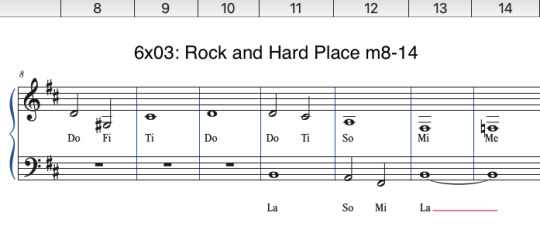
“Target” has a tonal center of F# and “RaHP” has a tonal center of D. I’m reluctant to say that either cue is “major” or “minor” because both have high amounts of chromaticism, so I’m just gonna stick with tonal/pitch centers. (It’s also worth noting “Target” ends with a tonal center of D, as seen below.)

The melodic content of both cues are very similar, and at times even identical. The rhythms are certainly identical (half note, half note, whole note). Using solfege (another way to denote scale degrees) you can see that both cues also contain a distinct, recurring motif of a descending half step followed by a descending leap: Do, Ti, So; Do, Ti, Mi; etc.
(I didn’t include the entire transcription for each cue here for you to see because I can’t put that many images in one post lmao but you should be able to easily hear the next part of my analysis if you listen!)
The cue begins with a thin texture, just the half-step motif with some single notes in the bass to harmonize it, creating a sense of introspection. As each cue develops, the texture thickens—both in harmonic and rhythmic content—and the contemplative nature of the motif changes into something more urgent and intense (this is especially noticeable in the “Target” cue.) This change from introspection to urgency supports the narrative for each episode as both Nacho and Jimmy make a choice for someone they love.
In “Bagman” Jimmy resolves to not give up and die in the desert—to keep fighting to survive for Kim. He and Mike can’t keep hiding forever, so he makes himself a shining target with the space blanket to lure in the cartel member close enough for Mike to snipe him. The music builds and builds in intensity until Mike finally shoots the bad guy. In “Rock and Hard Place” Nacho has chosen to take the blame for Lalo’s death to save his father, and he is coming to terms with his impending death. The music swells as the van drives closer toward the Salamancas and reaches its climax as Nacho is dropped in front of the Salamancas.
There is also a small parallel between “RaHP” and the BrBa Theme!! The minor third motif at the beginning of the BrBa theme occurs a few times underneath the main melody in “RaHP”. The rhythm is augmented and slightly different, but it can still be heard as the BrBa Theme.
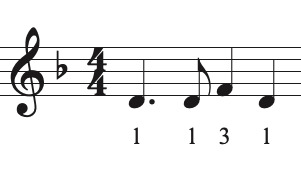

Maybe it’s a stretch, but to me the BrBa theme being associated with Nacho in this moment shows how Nacho’s story colors the events of BrBa even though he’s not there.
Anyway…that’s my analysis! I hope you all enjoyed it and found it interesting. Let me know what you think!
25 notes
·
View notes
Text
BCS and BrBa Music Analysis: #
BCS Fanfics:
Then All At Once the World Gets Bright
The Lighthouse Trail
Wish You Were Here
BCS Cover Songs
BCS theme song
Why Don't You Do It - 2x08: Fifi
Sugar Town - 3x01: Mabel
Big Rock Candy Mountain - 4x07: Something Stupid
Something Stupid - 4x07: Something Stupid
Winner Takes It All - 4x10: Winner
Welcome to My World - 5x01: Magic Man
Days of Wine and Roses - 6x01: Wine and Roses
Perfect Day - 6x09: Fun and Games
Other Cover Songs:
The Shankhill Butchers/The Decemberists
Please Please Please Let Me Get What I Want/ The Smiths
A Lack of Color/Death Cab For Cutie
River/Joni Mitchell
I Will Follow You Into the Dark/Death Cab For Cutie
Safe and Sound/Taylor Swift
Mia and Seb’s Theme from La La Land
Original Cross Stitch Designs: #
19 notes
·
View notes
Text
I have a few other bcs/brba music analysis in my back pocket that I hope to post eventually…but it’s gonna be a while because work is consuming my life right now 😔
#better call saul#brba#it’s gonna get worse before it gets better but work should let up some after thanksgiving
4 notes
·
View notes
Text
Reblogging this because I rewatched 38 snub and just realized that cue I analyzed in the credits is played earlier in the episode when Walt goes to Gus’s house to kill him, but is then stopped when Tyrus calls him (I didn't catch it on my last rewatch of that ep because I had jumped in on a Hyperbeam watch party and missed the scene 😅) anyway...the scene is here x
so it's another goddamn Kim/Walt parallel 😩😭
I cannot take any more of these...I am literally going to go insane.

as I've been watching s6 of bcs I've noticed the music cues are resembling the music cues from brba. to me it seems that as the timelines converge, the music is getting more and more similar. this prompted me to do a deep dive into music transcription and analysis between the two shows, which I'll post as I complete them. (side note: @jmcgools sent me an interview with dave porter which confirmed my theory!!!! interview is linked here x)
a few general comments before going into the first cue analysis....doing a full stylistic analysis entails analyzing SHMRG (Sound, Harmony, Melody, Rhythm, Growth). I am focusing mainly on the melodic and rhythmic elements because dave porter stays fairly consistent in the sound, harmonic, and growth elements throughout both shows:
the sound/timbre used is typically guitars, various percussion, and other electronic sounds; the sound/texture is typically sparse, which fits dave's intention to keep the music subservient to the narrative.
the harmony is also sparse in both shows for the same reasons, and is either centered in a minor tonality or no tonality at all.
and with growth, dave masterfully follows the narrative, and so each cue is somewhat unique in that aspect.
the first comparison I've completed is between the credits from brba 4x02: thirty-eight snub x (the credits hit when jesse is dissociating in his house alone with his stereo music blasting behind him) and the scene in bcs 6x04: hit and run x is when kim confronts the people tailing her


the music cue in the credits scene is short-lived, but has distinct melodic content that is recognizable in hit and run. the pattern starts with A, C, Db, C, then develops in measure 4-5 into A, C, Db, F, E. the developed melodic contour is repeated almost exactly in hit and run in measure 7-8. only the rhythm changes slightly
narratively, both scenes have an undercurrent of anxiety and dread. the minor 2nd motions between the C and Db and the F and E both accomplish that (think the jaws theme). the hit and run cue increases the intensity with the brief ostinato (repeating pattern in the bass line), continuing the minor 2nd motif between the C and Db. this minor 2nd motif is even further developed in the last 4 measures of the cue with the descending G, F#, F and then it ends with a tritone between A and Eb (one of the most unstable intervals) leaving the viewer unsettled.
These are both very short cues, but they have a lot packed into them! As with all of the music in brba and bcs, the creators use it sparingly, but when it is used it makes it that much more impactful.
This posted ended up being waaaaaay longer than I intended 😅 so thanks for reading this far! Let me know what you think or if you have any interpretations yourself. and feel free to drop suggestions for other cues for me to analyze! I’m hunting down cues to compare in my rewatches, but I know for sure that I won’t catch all of them lol
bcs/brba music analysis 1/??
#better call saul#brba#bcs/brba music analysis#kim wexler#walter white#hit and run#38 snub#not another kim/walter parallel 😩😩😩#i pretend i do not see it
103 notes
·
View notes
Text
This is such a great analysis and I loved reading it!
I noticed that the music cues had shifted as well, I wonder where they’ll take it and how similar they’ll become. I need to rewatch BrBa to see if I can catch them.
The music supervision is excellent in BCS too, especially for Kim and Jimmy, I wonder what direction they’ll take that in.
as I've been watching s6 of bcs I've noticed the music cues are resembling the music cues from brba. to me it seems that as the timelines converge, the music is getting more and more similar. this prompted me to do a deep dive into music transcription and analysis between the two shows, which I'll post as I complete them. (side note: @jmcgools sent me an interview with dave porter which confirmed my theory!!!! interview is linked here x)
a few general comments before going into the first cue analysis....doing a full stylistic analysis entails analyzing SHMRG (Sound, Harmony, Melody, Rhythm, Growth). I am focusing mainly on the melodic and rhythmic elements because dave porter stays fairly consistent in the sound/timbre, harmonic, and growth elements throughout both shows.
the sound/timbre used is typically guitars, various percussion, and other electronic sounds; the sound/texture is typically sparse, which fits dave's intention to keep the music subservient to the narrative.
the harmony is also sparse in both shows for the same reasons, and is either centered in a minor tonality or no tonality at all.
and with growth, dave masterfully follows the narrative, and so each cue is somewhat unique in that aspect.
the first comparison I've completed is between the credits from brba 4x02: thirty-eight snub x (the credits hit when jesse is dissociating in his house alone with his stereo music blasting behind him) and the scene in bcs 6x04: hit and run x is when kim confronts the people tailing her


the music cue in the credits scene is short-lived, but has distinct melodic content that is recognizable in hit and run. the pattern starts with A, C, Db, C, then develops in measure 4-5 into A, C, Db, F, E. the developed melodic contour is repeated almost exactly in hit and run in measure 7-8. only the rhythm changes slightly
narratively, both scenes have an undercurrent of anxiety and dread. the minor 2nd motions between the C and Cb and the F and E both accomplish that (think the jaws theme). the hit and run cue increases the intensity with the brief ostinato (repeating pattern in the bass line), continuing the minor 2nd motif between the C and Db. this minor 2nd motif is even further developed in the last 4 measures of the cue with the descending G, F#, F and then it ends with a tritone between A and Db (one of the most unstable intervals) leaving the viewer unsettled.
These are both very short cues, but they have a lot packed into them! As with all of the music in brba and bcs, the creators use it sparingly, but when it is used it makes it that much more impactful.
This posted ended up being waaaaaay longer than I intended 😅 so thanks for reading this far! Let me know what you think or if you have any interpretations yourself. and feel free to drop suggestions for other cues for me to analyze! I’m hunting down cues to compare in my rewatches, but I know for sure that I won’t catch all of them lol
bcs/brba music analysis 1/??
103 notes
·
View notes